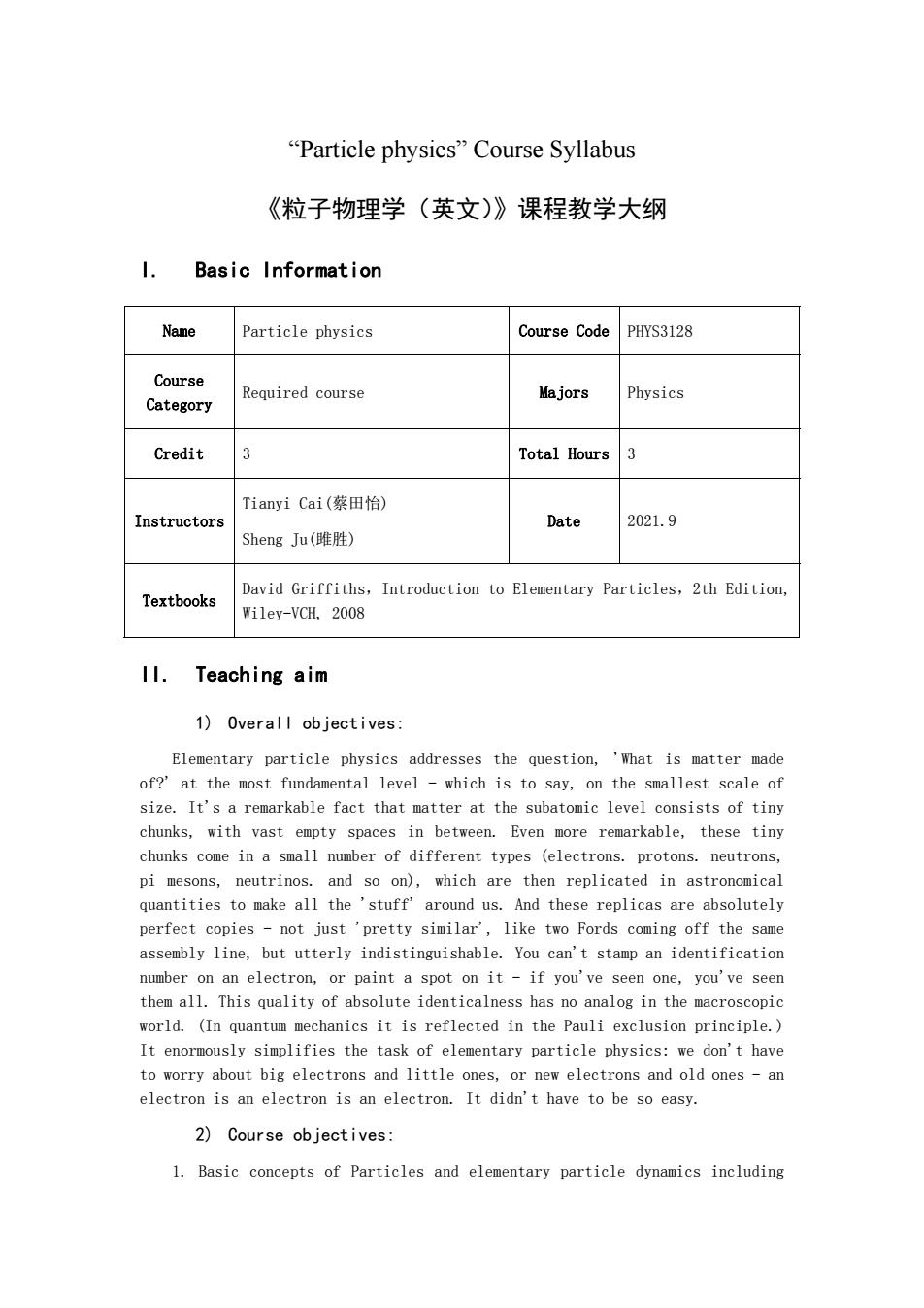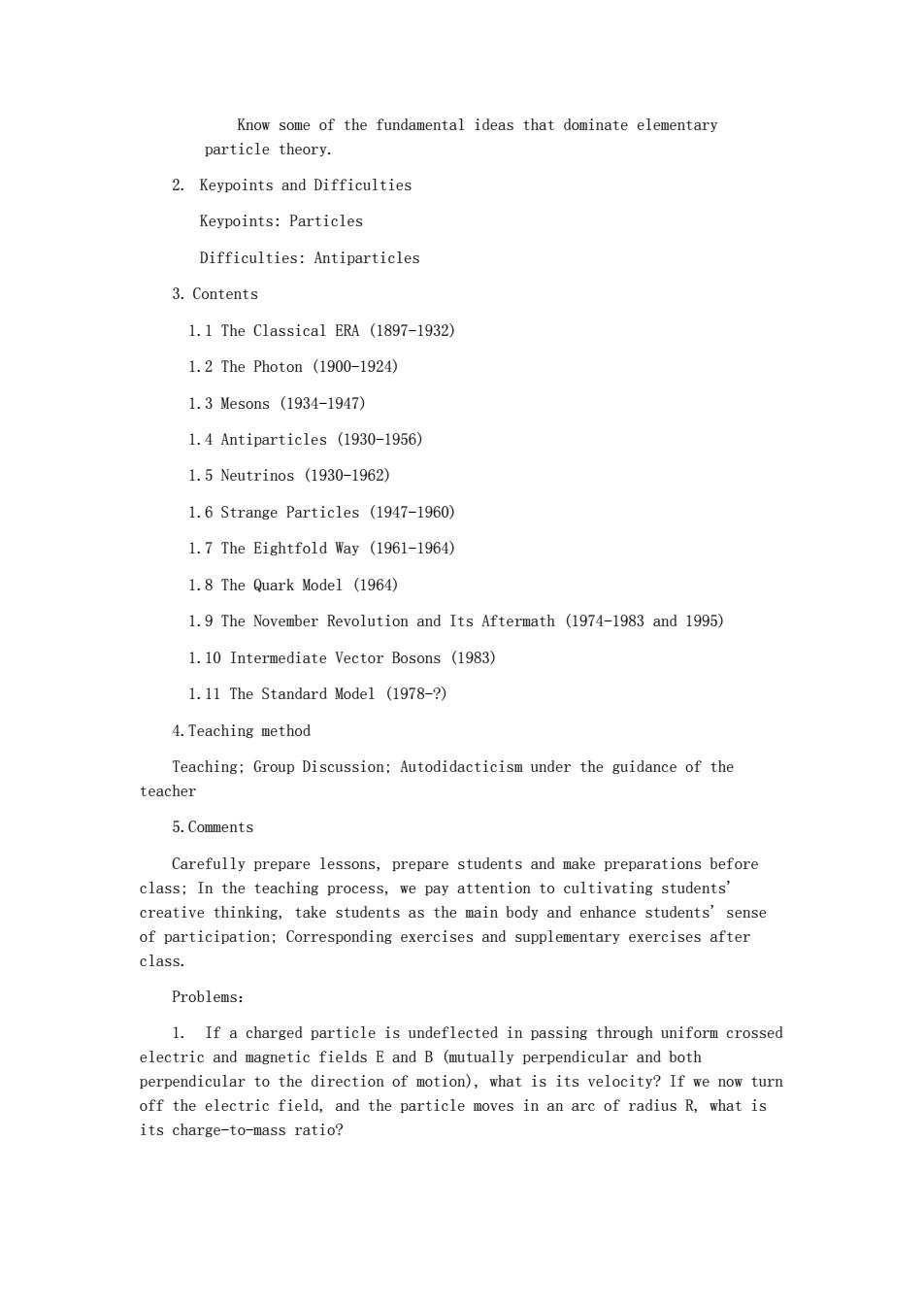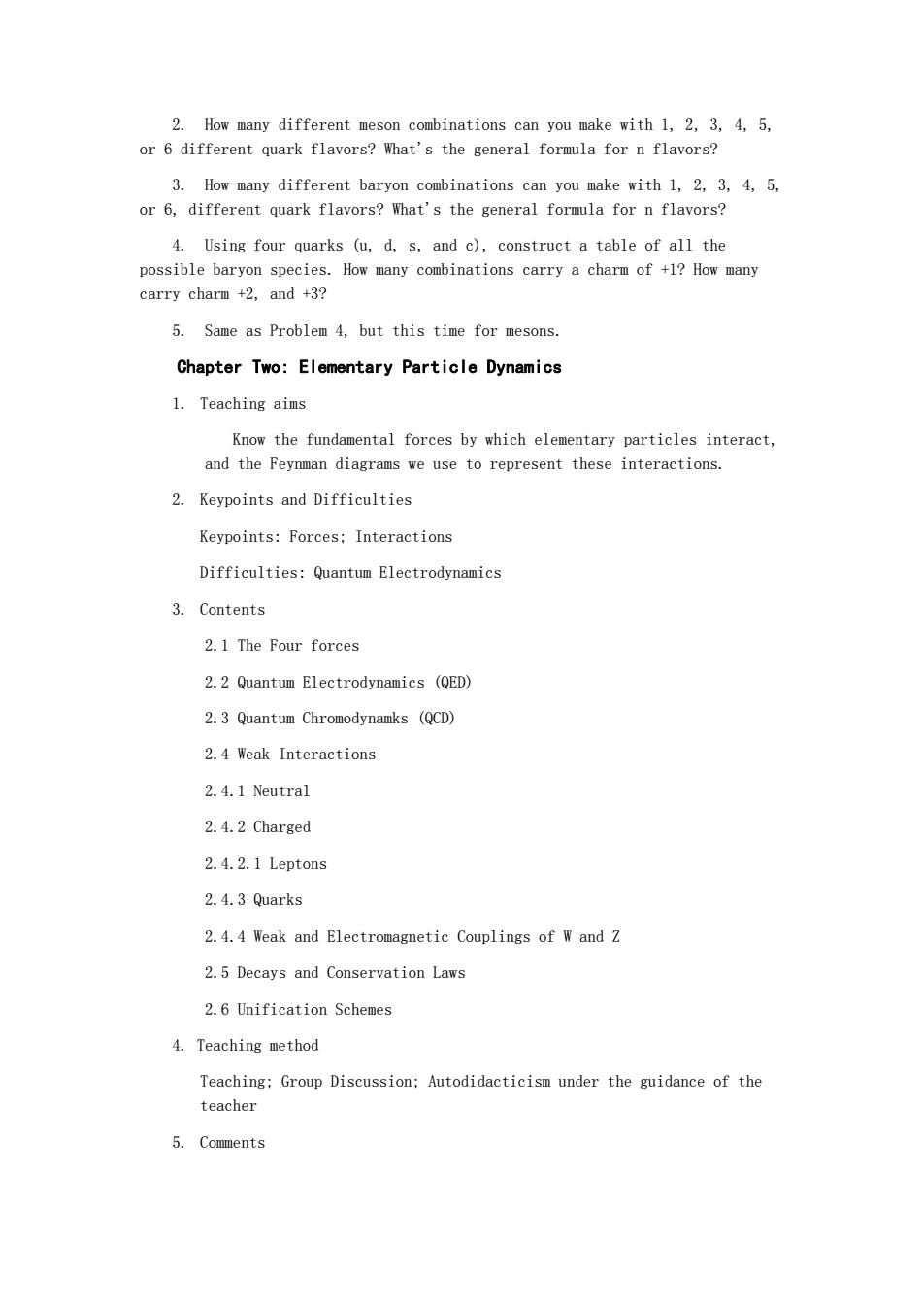
"Particle physics"Course Syllabus 《粒子物理学(英文)》课程教学大纲 1. Basic Information Name Particle physics Course CodePHYS3128 Course Category Required course Majors Physics Credit Total Hours3 Tianyi Cai(蔡田怡) Instructors Date 2021.9 Sheng Ju(睢胜) Textbooks David Griffiths,Introduction to Elementary Particles,2th Edition, Wiley-VCH.2008 1I.Teaching aim 1)Overall objectives: Elementary particle physics addresses the question,'What is matter made of?at the most funda ental level-which is to say, on the smallest scale of size.It's a remarkable fact that matter at the subatomic level consists of tiny chunks,with vast empty spaces in between.Even more remarkable,these tiny chunks come in a small number of different types (electrons.protons.neutrons, pi mesons.neutrinos.and so on).which are then replicated in astronomical quantities to make all the'stuff'around us.And thes replicas are absolutely perfect copies-not just'pretty similar like two Fords coming off the same assembly line,but utterly indistinguishable.You can't stamp an identification number on an electron,or paint a spot on it-if you've seen one,you've seen them all.This quality of absolute identicalness has no analog in the macroscopic world.(In quantum mechanics it is reflected in the Pauli exclusion principle.) It enormously simplifies the task of elementary particle physics:e don't have to worry about big electrons and little ones,or new electrons and old ones-an electron is an electron is an electron.It didn't have to be so easy. 2)Course objectives: 1.Basic concepts of Particles and elementary particle dynamics including
“Particle physics” Course Syllabus 《粒子物理学(英文)》课程教学大纲 I. Basic Information Name Particle physics Course Code PHYS3128 Course Category Required course Majors Physics Credit 3 Total Hours 3 Instructors Tianyi Cai(蔡田怡) Sheng Ju(雎胜) Date 2021.9 Textbooks David Griffiths,Introduction to Elementary Particles,2th Edition, Wiley-VCH, 2008 II. Teaching aim 1) Overall objectives: Elementary particle physics addresses the question, 'What is matter made of?' at the most fundamental level - which is to say, on the smallest scale of size. It's a remarkable fact that matter at the subatomic level consists of tiny chunks, with vast empty spaces in between. Even more remarkable, these tiny chunks come in a small number of different types (electrons. protons. neutrons, pi mesons, neutrinos. and so on), which are then replicated in astronomical quantities to make all the 'stuff' around us. And these replicas are absolutely perfect copies - not just 'pretty similar', like two Fords coming off the same assembly line, but utterly indistinguishable. You can't stamp an identification number on an electron, or paint a spot on it - if you've seen one, you've seen them all. This quality of absolute identicalness has no analog in the macroscopic world. (In quantum mechanics it is reflected in the Pauli exclusion principle.) It enormously simplifies the task of elementary particle physics: we don't have to worry about big electrons and little ones, or new electrons and old ones - an electron is an electron is an electron. It didn't have to be so easy. 2) Course objectives: 1. Basic concepts of Particles and elementary particle dynamics including

photon. mesons,antiparticles,neutrinos,the Quark model,Quantum Electrodynamics and Quantum Chromodynamics. 2.Application of concepts and rules including Relativistic Kinematics, Symmetries,Bound States,The Feynman Calculus,Quantum Electrodynamics, Electrodynamics and Chromodynamics of Quarks,Weak Interactions and Gauge Theories. 3)Corresponding relationship between curriculum objectives. graduation requirements and curriculum content Table I. Correspondence between course obiectives.course contents and graduation requirements Course Corresponding course Corresponding objectives content graduation requirements Graduation requirement 2:master the basic knowledge,basic physical experiment methods and experimental skills related to mathematics Chapter 1 Historical and physics,and have Introduction to the the ability to solve Elementary Particles problems,explain or Chapter 2 Elementary understand physical Particle Dynamics aws by using physical Course theories and methods objective Chapter 7 Quantum Electrodynamics Graduation requirement 3:understand the Chapter 8 Electrodynamics frontier and and Chromodynamics of development of physics Quarks the physical thought new technology,and be familiar with the impact of new discoveries. theories and technologies in physics on society. Graduation requirements 8:have the awareness
photon, mesons, antiparticles, neutrinos, the Quark model, Quantum Electrodynamics and Quantum Chromodynamics. 2. Application of concepts and rules including Relativistic Kinematics, Symmetries, Bound States, The Feynman Calculus, Quantum Electrodynamics, Electrodynamics and Chromodynamics of Quarks, Weak Interactions and Gauge Theories. 3) Corresponding relationship between curriculum objectives, graduation requirements and curriculum content Table I. Correspondence between course objectives, course contents and graduation requirements Course objectives Corresponding course content Corresponding graduation requirements Course objective 1 Chapter 1 Historical Introduction to the Elementary Particles Chapter 2 Elementary Particle Dynamics Chapter 7 Quantum Electrodynamics Chapter 8 Electrodynamics and Chromodynamics of Quarks Graduation requirement 2: master the basic knowledge, basic physical experiment methods and experimental skills related to mathematics and physics, and have the ability to solve problems, explain or understand physical laws by using physical theories and methods. Graduation requirement 3: understand the frontier and development of physics, the physical thought in new technology, and be familiar with the impact of new discoveries, theories and technologies in physics on society. Graduation requirements 8: have the awareness

of independent learning and lifelong learning and the ability to adapt to the society. Graduation requiremen 2:master the basic knowledge,basic physical experiment methods and experimental skills related to mathematics and physics,and hav Chapter 3 Relativistic the ability to solve Kinematics problems,explain or understand physical Course Chapter 4 Symmetries laws by using physical Chapter 5 Bound States theories and methods 2 Chapter 6 The Feynman Graduation requirements Calculus 7:have the ability of sub iect research. Chapter 9 Weak Interactions Graduation requirements 8:have the awareness of independent learning and lifelong learning and the ability to adapt to the society. 1II.Contents Chapter One:Historical Introduction to the Elementary Particles 1.Teaching aims Know how the various particles were first discovered,and how they fit into the overall scheme of things;
of independent learning and lifelong learning and the ability to adapt to the society. Course objective 2 Chapter 3 Relativistic Kinematics Chapter 4 Symmetries Chapter 5 Bound States Chapter 6 The Feynman Calculus Chapter 9 Weak Interactions Graduation requirement 2: master the basic knowledge, basic physical experiment methods and experimental skills related to mathematics and physics, and have the ability to solve problems, explain or understand physical laws by using physical theories and methods. Graduation requirements 7: have the ability of subject research, design, data processing and academic exchange. Graduation requirements 8: have the awareness of independent learning and lifelong learning and the ability to adapt to the society. III. Contents Chapter One: Historical Introduction to the Elementary Particles 1. Teaching aims Know how the various particles were first discovered, and how they fit into the overall scheme of things;

Know some of the fundamental ideas that dominate elementary particle theory. 2.Keypoints and Difficulties Keypoints:Particles Difficulties:Antiparticles 3.Contents 1.1 The Classical ERA (1897-1932) 1.2 The Photon(1900-1924) 1.3 Mesons(1934-1947) 1.4 Antiparticles (1930-1956) 1.5 Neutrinos(1930-1962) 1.6 Strange Particles (1947-1960) 1.7 The Eightfold Way (1961-1964) 1.8 The Quark Model (1964) 1.9 The November Revolution and Its Aftermath (1974-1983 and 1995) 1.10 Intermediate Vector Bosons (1983) 1.11 The Standard Model (1978-?) 4.Teaching method Teaching:Group Discussion:Autodidacticism under the guidance of the teacher 5.Comments Carefully prepare lessons,prepare students and make preparations before class:In the teaching process,we pay attention to cultivating students' creative thinking.take students as the main body and enhance students'sense of participation:Corresponding exercises and supplementary exercises after class. Problems: 1.If a charged particle is undeflected in passing through uniform crossed electric and magnetic fields e and b (mutually perpendicular and both the direetion of motio),hat is its velocity?If field d the particle oves i n ar ous ht i its charge-to-mass ratio?
Know some of the fundamental ideas that dominate elementary particle theory. 2. Keypoints and Difficulties Keypoints: Particles Difficulties: Antiparticles 3. Contents 1.1 The Classical ERA (1897-1932) 1.2 The Photon (1900-1924) 1.3 Mesons (1934-1947) 1.4 Antiparticles (1930-1956) 1.5 Neutrinos (1930-1962) 1.6 Strange Particles (1947-1960) 1.7 The Eightfold Way (1961-1964) 1.8 The Quark Model (1964) 1.9 The November Revolution and Its Aftermath (1974-1983 and 1995) 1.10 Intermediate Vector Bosons (1983) 1.11 The Standard Model (1978-?) 4.Teaching method Teaching; Group Discussion; Autodidacticism under the guidance of the teacher 5.Comments Carefully prepare lessons, prepare students and make preparations before class; In the teaching process, we pay attention to cultivating students' creative thinking, take students as the main body and enhance students' sense of participation; Corresponding exercises and supplementary exercises after class. Problems: 1. If a charged particle is undeflected in passing through uniform crossed electric and magnetic fields E and B (mutually perpendicular and both perpendicular to the direction of motion), what is its velocity? If we now turn off the electric field, and the particle moves in an arc of radius R, what is its charge-to-mass ratio?

2.How many different meson combinations can you make with 1,2,3,4,5, or 6 different quark flavors?What's the general formula for n flavors? 3.How many different baryon combinations can you make with 1,2.3.4,5. or 6,different quark flavors?What's the general formula for n flavors? 4.Using four quarks (u,d,s,and c),construct a table of all the possible baryon species.How many combinations carry a charm of +1?How many carry charm +2,and +3? 5.Same as Problem 4,but this time for mesons. Chapter Two:Elementary Particle Dynamics 1.Teaching aims Know the fundamental forces by which elementary particles interact and the Feynman diagrams we use to represent these interactions. 2.Keypoints and Difficulties Keypoints:Forces:Interactions Difficulties:Quantum Electrodynamics 3.Contents 2.1 The Four forces 2.2 Quantum Electrodynamics (QED) 2.3 Quantum Chromodynamks (OCD) 2.4 Weak Interactions 2.4.1 Neutral 2.4.2Charged 2.4.2.1 Leptons 2.4.3 Quarks 2.4.4 Weak and Electromagnetic Couplings of W and Z 2.5 Decays and Conservation Laws 2.6 Unification Schemes 4.Teaching method Teaching:Group Discussion:Autodidacticism under the guidance of the teacher 5.Comments
2. How many different meson combinations can you make with 1, 2, 3, 4, 5, or 6 different quark flavors? What's the general formula for n flavors? 3. How many different baryon combinations can you make with 1, 2, 3, 4, 5, or 6, different quark flavors? What's the general formula for n flavors? 4. Using four quarks (u, d, s, and c), construct a table of all the possible baryon species. How many combinations carry a charm of +1? How many carry charm +2, and +3? 5. Same as Problem 4, but this time for mesons. Chapter Two: Elementary Particle Dynamics 1. Teaching aims Know the fundamental forces by which elementary particles interact, and the Feynman diagrams we use to represent these interactions. 2. Keypoints and Difficulties Keypoints: Forces; Interactions Difficulties: Quantum Electrodynamics 3. Contents 2.1 The Four forces 2.2 Quantum Electrodynamics (QED) 2.3 Quantum Chromodynamks (QCD) 2.4 Weak Interactions 2.4.1 Neutral 2.4.2 Charged 2.4.2.1 Leptons 2.4.3 Quarks 2.4.4 Weak and Electromagnetic Couplings of W and Z 2.5 Decays and Conservation Laws 2.6 Unification Schemes 4. Teaching method Teaching; Group Discussion; Autodidacticism under the guidance of the teacher 5. Comments